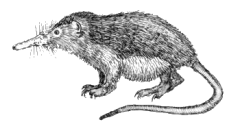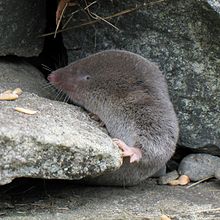Venomous mammal

Venomous mammals are animals of the
In spite of the rarity of venom among extant mammals, venom may be an ancestral feature among mammals, as venomous spurs akin to those of the modern platypus are found in most non-therian Mammaliaformes groups.[2]
Venom is much more common among other
Definitions
Several definitions of venomous animals have been proposed.[6]
Bücherl states that venomous animals must possess at least one venom gland, a mechanism for excretion or extrusion of the venom, and apparatus with which to inflict wounds.
Mebs writes that venomous animals produce venom in a group of cells or gland, and have a tool, the venom apparatus, which delivers the venom by injection during a bite or sting. The venom apparatus in this definition encompasses both the gland and the injection device, which must be directly connected.
Fry et al. found that a venom is a secretion produced in a specialized gland in one animal and delivered to a target animal through the infliction of a wound. This secretion must contain molecules that disrupt normal physiological processes so as to facilitate feeding or defense by the producing animal. Additionally, the feeding secretion of
Evolutionary history and paleontology
Venomous mammals may have been more common in the past. Extratarsal spurs observed in extinct Mesozoic mammals are homologous with those seen in extant monotremes, and this feature was widespread. Whether or not these extratarsal spurs served as a venom delivery system is up for debate. While species such as Gobiconodon and Zhangeotherium possessed an extratarsal spur, they are hypothesized to be nonvenomous due to the lack of the spur being hollow or channeled, as seen in modern venomous Ornithorhyncus. Whether or not the lack of venom is due to the loss of a basal trait is difficult to determine with current fossil records.[2]
In 2005, Fox and Scott presented evidence of a venom delivery system in late
The genus Beremendia may have featured individuals with a venom delivery system. The first lower incisor of several species exhibited a groove that may have served as a canal for venom to travel from a venom gland to the tip of the tooth. Support for a venom gland is seen in the fossa in the mandibular symphysis. Also, Beremendia is phylogenetically close to Solenodon, which has extant members that are venomous.[9][10] Euchambersia is an example of a fossil therapsid (a relative of mammals) with grooved teeth, and maxillary fossa to match, indicating the presence of venom glands. Euchambersia differs in that the upper canines are the teeth that are grooved, and the grooves are almost enclosed, forming a tube.[9]
More recently, nonhomologous species in the genus Nesophontes were hypothesized to be venomous. Species within Nesophontes exhibit grooved upper canines, similar to other species suspected of venom delivery. Where Nesophontes differ, however, is in the presence of grooves on the first and second upper premolars. The grooves are similar in morphology to helodermatid lizards, which feature a deep anterior groove and shallow posterior groove, as well as grooves on other teeth, which suggests that Nesophontes grooved premolars also aided in delivery of venom in addition to the upper canines. Nesophontes mandibular morphology is similar to that of existing venomous Eulipotyphlans, which further supports the hypothesis that they possessed venom.[11]
Examples
Eulipotyphla (previously known as insectivores)
With the exception of vampire bats, the Eulipotyphla are the only mammals so far observed to produce toxic saliva. These species have significantly enlarged and granular submaxillary
The

The
The European mole (Talpa europaea), and possibly other species of mole,[15] have toxins in their saliva that can paralyze earthworms, allowing the moles to store them alive for later consumption.[16]
Male platypus

Both male and female platypuses (
When platypuses attack, they drive their hind legs together with considerable force so that the spurs are embedded in the flesh caught between and if venom is being produced, a few milliliters are injected by repeated jabbing.[17] The spurs have enough strength to support the weight of the platypus, which often hangs from the victim, requiring assistance for removal.
Most of the evidence now supports the proposition that the venom system is used by males on one another as a weapon when competing for females, taking part in sexual selection. During this season, males become more aggressive and are found with punctures in their bodies, especially in the tail region. Adult male platypuses largely avoid each other, outside of this mating rivalry.[6]
Platypus venom is likely retained from its distant non-monotreme ancestors, being the last living example of what was once a common characteristic among mammals.[2] Fossil records show that venom delivery systems were not sexually dimorphic in ancestral monotremes.[18] It has been hypothesized that venom spurs were once used for defense against predators.[18] Proteins derived from platypus venom are being studied for potential analgesic properties.[19]
Vampire bats
The definition of venom by Fry et al. (see
Primates
Slow lorises (of the genera Nycticebus and Xanthonycticebus[21]) are accepted as the only known venomous primate.[20] Slow loris venom was known in folklore in their host countries throughout southeast Asia for centuries, but dismissed by Western science until the 1990s.[20] There are nine recognised species of this small-bodied nocturnal primate.[22] They possess a dual composite venom consisting of saliva and brachial gland exudate, a malodourous fluid forming from an apocrine sweat gland on the animal's forearm.[23] Both fluids have been demonstrated as being venomous individually and creating a more potent venom when mixed.[23] Slow loris brachial gland exudate (BGE) has been shown to possess up to 142 volatile components, and possesses a variant of the cat allergen protein Fel-D1. The BGE has several ecological functions including anti-parasitic defence[24] and communication. Slow loris saliva has been shown to be cytotoxic to human skin cells in laboratory experiments without the administration of BGE.[25]
The venom is administered through morphologically distinct dentition in the form of an adapted toothcomb.[23] In the wild envenomation occurs from intraspecific competition; whereby two slow lorises fight for mates, food or territory. Slow loris inflicted wounds are a major cause of premature death in zoo and wildlife slow loris populations,[26] often resulting in festering and necrotic wounds. Slow loris envenomation in humans is rare, but can result in near fatal anaphylactic shock.[27] A suite of additional effects of the venom have been documented including mild to permanent disfigurement and mobility loss.[28] The study of slow loris venom was brought to the public attention in 2012 by the research of the primatologist Prof. K.A.I Nekaris and in her BBC documentary The Jungle Gremlins of Java.[29]
Arguably venomous mammals
Eulipotyphla (previously known as insectivores)
Rodentia

The African crested rat (Lophiomys imhausi) has a mane of long, coarse black-and-white banded hairs which extends from the top of the animal's head to just beyond the base of the tail. This mane is bordered by a broad, white-bordered strip of hairs covering an area of glandular skin on the flank. When the animal is threatened or excited, the mane erects and this flank strip parts, exposing the glandular area. The hairs in this flank area are highly specialised; at the tips they are like ordinary hair, but are otherwise spongy, fibrous, and absorbent. The rat is known to deliberately chew the roots and bark of the poison-arrow tree (Acokanthera schimperi), so-called because human hunters extract a toxin, ouabain, to coat arrows that can kill an elephant. After the rat has chewed the tree, it deliberately slathers the resulting mixture onto its specialised flank hairs which are adapted to rapidly absorb the poisonous mixture, acting like a lamp wick. It thereby creates a defense mechanism that can sicken or even kill predators which attempt to bite it.[31][32][33][34]
Chemical defence
See also
- Venomous fish
- Toxicofera
- Toxic birds
- List of venomous animals
- Venomous snakes
- Poisonous amphibians
References
Notes
- PMID 1641406.
- ^ a b c Jørn H. Hurum, Zhe-Xi Luo, and Zofia Kielan-Jaworowska, Were mammals originally venomous?, Acta Palaeontologica Polonica 51 (1), 2006: 1-11
- PMID 20080749.
- ^ "Venomous Amphibians (Page 1) - Reptiles (Including Dinosaurs) and Amphibians - Ask a Biologist Q&A". Askabiologist.org.uk. Retrieved 2010-07-28.
- JSTOR 1443606.
- ^ PMID 22410495.
- S2CID 4322624.
- S2CID 45645935.
- ^ S2CID 54602365.
- S2CID 86133561.
- S2CID 86625812.
- ^ PMID 1641406.
- ^ PMID 33782124.
- ISBN 9780121389024.
- ^ A-Z-Animals.com. "Mole (Talpidae) - Animals - A-Z Animals - Animal Facts, Information, Pictures, Videos, Resources and Links". A-Z Animals. Retrieved 2010-07-28.
- ^ Mukherjee, Sarah (2008-01-25). "Science/Nature | Searching for nature's tunnellers". BBC News. Retrieved 2010-07-28.
- doi:10.1071/zo09046.
- ^ PMID 24699339.
- PMID 19152842.
- ^ PMID 24074353.
- ISSN 1860-0743.
- ^ Primates, All The World's. "Colin Groves' Taxonomy Introduction - All The World's Primates". www.alltheworldsprimates.org. Retrieved 2018-04-21.
- ^ ISBN 9781441932501.
- PMID 25528386.
- ^ Gardiner, Matthew; Samuel, Priya; Nekaris, K.A.I (2017). "The Cytotoxic Effect of Slow Loris (Nycticebus) Venom on Human Cancer". Folia Primatologica. 88 (2): 10 – via google scholar.
- S2CID 37481446.
- PMID 25309586.
- ^ Gardiner, Matthew; Weldon, Ariana; Gibson, Nancy; Poindexter, Stephanie; Nekaris, K.A.I. "Survey of practitioners handling slow lorises (Primates: Nycticebus): an assessment of the harmful effects of slow loris bites – Journal of Venom Research". jvenomres.co.uk. Retrieved 2018-04-21.
- ^ "Jungle Gremlins of Java, 2011-2012, Natural World - BBC Two". BBC. Retrieved 2018-04-21.
- S2CID 4293159.
- ^ a b Morelle, Rebecca (2011). "African crested rat uses poison trick to foil predators". BBC.co.uk. Retrieved November 2, 2013.
- ^ Welsh, J. (2011). "Giant rat kills predators with poisonous hair". LiveScience. Retrieved August 2, 2011.
- ^ "Rat makes its own poison from toxic tree". University of Oxford. 2011. Archived from the original on November 6, 2013. Retrieved November 2, 2013.
- PMID 21813554.
Bibliography
- Folinsbee, K; Muller, J; Reisz, RR (2007). "Canine grooves: morphology, function, and relevance to venom". Journal of Vertebrate Paleontology. 27 (2): 547–551. S2CID 54602365.
- Fox RC, Scott CS (2005). "First evidence of a venom delivery apparatus in extinct mammals". Nature. 435 (7045): 1091–3. S2CID 4322624.
- Orr, CM; Delezene, LK; Scott, JE; Tocheri, MW; Schwartz, GT (2007). "The comparative method and the inference of venom delivery systems in fossil mammals". Journal of Vertebrate Paleontology. 27 (2): 541–546. S2CID 45645935.
External links
- Shrew handbook
- Shrew venom
- Northern short-tailed shrew venom
- Platypus venom
- Slow Loris Research by a toxicologist- includes photos.
- Slow loris venom
